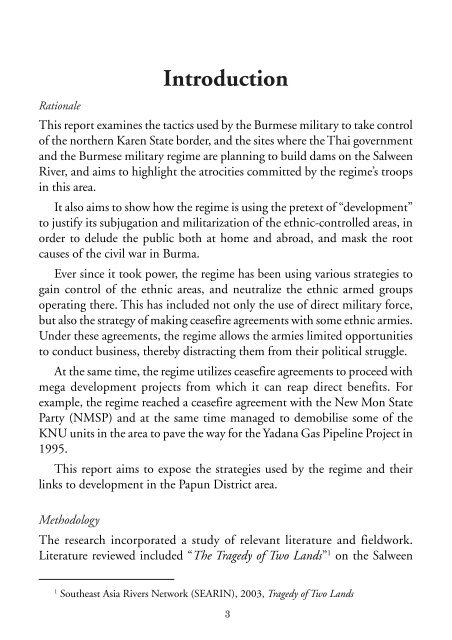Damming at gunpoint(English Version)
- No tags were found...
You also want an ePaper? Increase the reach of your titles
YUMPU automatically turns print PDFs into web optimized ePapers that Google loves.
R<strong>at</strong>ionale<br />
Introduction<br />
This report examines the tactics used by the Burmese military to take control<br />
of the northern Karen St<strong>at</strong>e border, and the sites where the Thai government<br />
and the Burmese military regime are planning to build dams on the Salween<br />
River, and aims to highlight the <strong>at</strong>rocities committed by the regime’s troops<br />
in this area.<br />
It also aims to show how the regime is using the pretext of “development”<br />
to justify its subjug<strong>at</strong>ion and militariz<strong>at</strong>ion of the ethnic-controlled areas, in<br />
order to delude the public both <strong>at</strong> home and abroad, and mask the root<br />
causes of the civil war in Burma.<br />
Ever since it took power, the regime has been using various str<strong>at</strong>egies to<br />
gain control of the ethnic areas, and neutralize the ethnic armed groups<br />
oper<strong>at</strong>ing there. This has included not only the use of direct military force,<br />
but also the str<strong>at</strong>egy of making ceasefire agreements with some ethnic armies.<br />
Under these agreements, the regime allows the armies limited opportunities<br />
to conduct business, thereby distracting them from their political struggle.<br />
At the same time, the regime utilizes ceasefire agreements to proceed with<br />
mega development projects from which it can reap direct benefits. For<br />
example, the regime reached a ceasefire agreement with the New Mon St<strong>at</strong>e<br />
Party (NMSP) and <strong>at</strong> the same time managed to demobilise some of the<br />
KNU units in the area to pave the way for the Yadana Gas Pipeline Project in<br />
1995.<br />
This report aims to expose the str<strong>at</strong>egies used by the regime and their<br />
links to development in the Papun District area.<br />
Methodology<br />
The research incorpor<strong>at</strong>ed a study of relevant liter<strong>at</strong>ure and fieldwork.<br />
Liter<strong>at</strong>ure reviewed included “The Tragedy of Two Lands” 1 on the Salween<br />
1<br />
Southeast Asia Rivers Network (SEARIN), 2003, Tragedy of Two Lands<br />
3


















